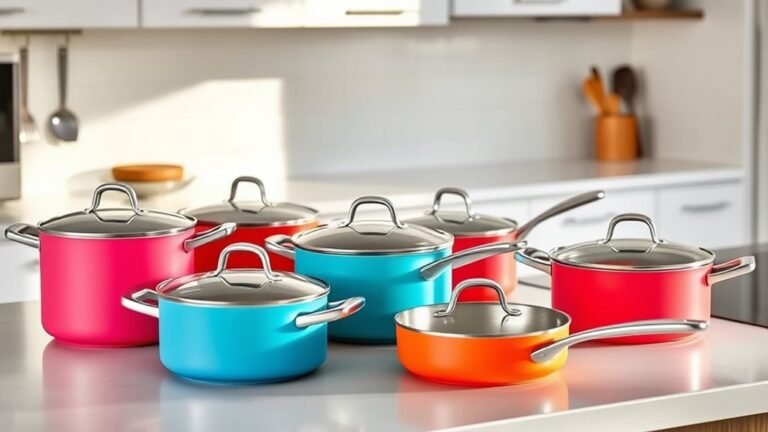3 Best AI-Powered Kitchen Waste Robots for Composting: The Future of Eco-Friendly Cooking
Imagine a kitchen where food scraps don’t pile up or stink up your home, thanks to cutting-edge AI-powered waste robots. These sleek devices use sensors, smart sorting, and quick composting cycles to turn scraps into garden-ready soil fast—some within hours. With features like odor control, noise reduction, and space-efficient designs, they’re changing how we handle waste at home. Curious which models lead the way and how they really perform? The details might just surprise you.
Electric Kitchen Composter, 4L Countertop Food Waste Recycler
- 🌱Smart Electric Composter for the Kitchen: The ultimate solution for turning food scraps and waste into...
- ♻️Efficient Waste Reduction: Using high-temperature drying, grinding, and cooling methods, this kitchen composter...
If you want an easy way to handle kitchen waste, the Electric Kitchen Composter might be just what you need. It is small and fits neatly on your kitchen counter. It turns food scraps into rich compost in just three hours. The device is lightweight, made of aluminum, and weighs around 15.7 pounds. It operates quietly below 40 decibels. It also doesn’t leave bad smells behind. This composter has features like auto-cleaning, a clear lid, and different modes for crushing, fermenting, or cleaning. It makes composting simple and mess-free. Say goodbye to overflowing trash or smelly bins!
Best for people who care about the environment and garden lovers who want to make their own compost easily.
Here are some pros:
- Fits easily on your countertop, looks nice in modern kitchens
- Makes compost fast, in just three hours
- Quiet operation and odor control with a big carbon filter
- Auto-cleaning feature keeps it tidy
However, there are some cons:
- It only holds 4 liters, so you might need to empty it often if your household is big
- Replacement filters can be hard to find and may need changing after about 1000 hours
- Some users find the troubleshooting guides unclear and may have a hard time setting it up at first
4L Electric Composter for Kitchen
- ✅90% Volume Reduction in Hours: The Growell electric composter uses a three-stage process—grinding, high-temperature...
- ✅4L Large Capacity & Heavy-Duty Blades: Designed with a 4L large-capacity inner barrel, this compost machine meets the...
The Growell 4L Electric Composter is a great gadget for your kitchen. It turns food waste into compost quickly and easily. It works in three steps: grinding, drying at high heat, and cooling. In just 3 to 6 hours, it can cut waste volume by about 90%. Its small, sleek shape fits easily on your countertop, saving space. Made with strong materials like aluminum alloy and stainless steel, it’s built to last. It has different modes—automatic, manual, and fermentation—so you can choose what works best. The dual carbon filter blocks odors and keeps pests away. It’s simple to use, quick, and helps you reduce food scraps without hassle.
Best For: Homes that want an easy, quiet way to reduce kitchen waste and make compost.
Pros:
- Cuts food waste volume by 90% in hours with three steps.
- Small and stylish design fits on countertops.
- Multiple modes and auto-cleaning make it simple to operate.
Cons:
- The grinding sound can be loud at times.
- Waste may need to be mixed with soil or fermented for full compost.
- Costs more upfront than regular compost bins or manual methods.
This composter is perfect if you want to reduce waste fast, save space, and avoid unpleasant smells. It’s easy to use and makes composting simple for your home.
Electric Composter for Kitchen Indoor, 2.5L Countertop Compost Bin
- Rapid & Efficient Composting: The Growell electric composter efficiently reduces kitchen waste by over 85% in just 4...
- Experience Odor-Free Indoor Composting: The built-in activated carbon filter in the food waste composter ensures 100%...
The Growell Electric Composter EC02 is a small kitchen gadget made for people who want to cut back on waste but don’t have much space. It has a capacity of 2.5 liters, so it fits easily on most counters. This composter can turn food scraps into compost quickly, in just four hours, especially when using the fast mode. It crushes waste into tiny pieces that look like coffee grounds, making it easy to use for your garden or compost pile.
The device is built with strong materials like stainless steel and aluminum alloy. It also has an LED display, so you can control it easily. An activated carbon filter inside helps eliminate bad smells, keeping your kitchen fresh and odor-free. The sealed design adds extra protection against odors.
This composter is small but effective. It helps reduce waste and is a great tool for people who want to live more eco-friendly indoors. It’s ideal for small households, people living in apartments, or anyone who wants a simple way to compost at home.
Pros:
- Turns over 85% of food waste into compost in just four hours.
- Small size and stylish look fit easily on any kitchen counter.
- Uses an activated carbon filter to catch bad smells.
Cons:
- The 2.5-liter size might not be enough for big households.
- You need to replace filters after about 90 uses, which costs extra.
- Sometimes buttons can be pressed by accident, so handle it carefully.
This composter makes it easy to reduce trash, keep your kitchen smelling good, and help the environment—all with a small, smart gadget.
Factors to Consider When Choosing Ai-Powered Kitchen Waste Robots for Composting
When choosing an AI-powered kitchen waste robot, you’ll want to consider its capacity and size to make certain it fits comfortably in your space and handles your typical waste volume. Odor control is also vital—nobody wants their smart gadget smelling like last week’s leftovers—and noise level matters if you prefer a quiet, unobtrusive operation. Finally, look at processing speed, ease of maintenance, and ease of use, so your composting routine stays straightforward without turning into a tech headache.
Capacity and Size
Choosing the right size for an AI kitchen waste robot is very important. The size affects how well the robot works and how often you need to empty it. If you have a big family or cook a lot, pick a large capacity. A bigger unit can hold more food waste at once, so you won’t need to empty it as often. Just remember, bigger models take up more space on your counter, like a small storage bin.
If you live alone or have a small kitchen, a smaller unit might be better. These are easier to fit in tight spaces, but you will need to empty them more often. Think about how much waste you produce each day.
Some robots have adjustable or multiple compartments. These let you sort different types of waste at the same time. This can make your composting process more efficient and simple.
Keep in mind, size is not only about how much the robot can hold. It also impacts how fast it can process your waste. Choose a model that matches your waste amount to help your eco goals stay on track.
Odor Control Efficacy
Good odor control is important when picking a kitchen waste robot for composting. No one wants their kitchen to smell bad like trash. These robots use special filters, like activated charcoal, that absorb and stop bad smells. It’s important to replace these filters regularly, about every 900 to 1000 hours, so odors don’t get through. Many robots have sealed designs that keep smells inside, even during busy composting. Some models also have sensors that detect odors. When they smell something, they can activate neutralizers or tell you when to change the filters. Using odor-free modes and materials like charcoal or zeolite makes these robots work better. When choosing one, look for good filters, sealed designs, and sensors. These features help keep your kitchen smelling fresh.
Noise Level Considerations
Keeping noise low is important when choosing a kitchen waste robot with AI. Most models run quietly and stay below 45 decibels. That means they won’t turn your kitchen into a noisy place. The loudest parts are during grinding and drying, which reach around 40-45 decibels. That’s similar to a quiet chat. Some robots have features to block out sound or add insulation, which helps keep noise down. When the robot is cleaning or on standby, it is even quieter—often below 40 decibels. This makes it easy to relax without extra noise. When you pick a robot, check its decibel rating. A lower number means less noise. This helps you find a model that won’t disturb your home’s peace. A good waste robot should help, not disturb, your daily life.
Processing Speed and Efficiency
When choosing an AI-powered kitchen waste robot for composting, speed and efficiency matter. Most models turn food scraps into compost in about 3 to 6 hours per batch. Look for a robot that can process waste quickly without long pauses. Efficiency shows how much the waste shrinks. Good models reduce waste by around 85% to 90%. This means there’s very little leftover material. Choose a robot with strong, low-speed blades. These blades can handle tough waste like bones and shells while still working fast. Some robots have separate steps, such as grinding, drying, and cooling. These help break down waste completely in a short time. Many models also have modes you can set or sensors that help the robot work better. They make composting faster and allow you to add waste all the time. Picking a robot with these features can make composting simple, quick, and smooth.
Ease of Maintenance
When choosing an AI-powered kitchen waste robot, easy maintenance is very important. Pick a model that has parts you can take apart easily, like buckets or filters. This makes cleaning faster and simpler. Some robots have automatic cleaning or self-sanitizing features. These save you time and keep the machine clean with little effort. Look for indicator lights or alerts that tell you when to change filters or clean the machine. Dishwasher-safe parts are a big plus because you can wash them in the dishwasher instead of handwashing. A robot with simple maintenance needs lasts longer and works better. It helps you stay away from breakdowns and keeps your kitchen running smoothly.
Compatibility and Modes
Your kitchen waste robot needs to be compatible with your kitchen and easy to use. Check if it has different modes like crushing, fermenting, and cleaning. These modes help you handle all kinds of food waste easily. Look at the size of the robot—make sure it fits on your counter and that it works with your power outlets. This prevents you from needing extension cords or rearranging things in your kitchen. Also, see if the modes can be customized. This lets you adjust how the machine processes waste based on the type of food scraps you have.
Find out if the modes work automatically or if you need to control them manually. Automatic modes are simpler and save you work. Manual controls give you more options. Some robots show clear signals or have apps that let you know what’s happening. This way, you can keep an eye on the process and make changes if needed. A user-friendly design makes it easier and more fun to use your kitchen waste robot every day.
Durability and Material Quality
When choosing a kitchen waste robot, durability and material quality matter a lot. Look for a device made from strong, corrosion-resistant materials like stainless steel, aluminum, or tough plastics. These materials are important because kitchens are humid, and the machine must handle moisture well. A good waste robot needs to withstand daily grinding, drying, and cooling without cracking or warping. Strong materials also help keep odors inside the machine and prevent leaks. Well-built devices are less likely to break down or need repairs later. Choosing a sturdy, well-made robot means it will last longer and work reliably. This makes your kitchen cleaner, safer, and easier to use. Investing in a durable robot saves you money and effort over time. In the end, a good-quality, durable waste robot makes composting simpler and more sustainable.
Cost and Warranty
When you look at AI kitchen waste robots, price and warranty matter a lot. These robots usually cost between $200 and over $1,000. The price depends on the features, how big the compost bin is, and the technology inside. More expensive models often have better sensors and larger bins. This can save you time and make the job easier.
Most warranties last from one to three years. They usually cover factory defects and some repair issues. Sometimes, you can pay extra to extend the warranty or buy a service plan. This can be worth it if you want extra peace of mind. Always read the warranty details carefully. Find out what parts are covered, like electronics or mechanical parts. Knowing this can help you avoid surprise repair costs later.
Choosing a good warranty saves money in the long run. It also means you will get support if something breaks. This makes using your eco-friendly robot less stressful and more fun.
FAQs
How Do Ai-Powered Models Improve Composting Efficiency?
AI-powered models improve composting efficiency by analyzing waste data in real time, optimizing decomposition processes, and controlling environmental factors, so you can compost faster and more effectively, reducing waste and supporting eco-friendly cooking practices.
Are AI Kitchen Waste Robots Suitable for Small Apartments?
You’ll find AI kitchen waste robots suitable for small apartments, as they’re compact, efficient, and automate composting. This helps you reduce waste and promote sustainability, even in limited space, with minimal effort required on your part.
What Safety Features Are Included in AI Composting Devices?
You should check if the AI composting device has safety sensors preventing overheating, automatic shut-offs during malfunctions, secure lids to prevent spills, and safety certifications. These features guarantee secure, efficient, and user-friendly operation in your kitchen.
How Often Do AI Composters Require Maintenance?
You’ll need to check your AI composter regularly, usually weekly, to empty collections and clean sensors. Routine maintenance keeps it running smoothly, prevents odors, and guarantees effective composting, making eco-friendly cooking more hassle-free.
Can AI Composters Process Non-Food Waste Effectively?
You might wonder if AI composters can handle non-food waste effectively. Often, they are designed mainly for organic kitchen scraps, but some models can process certain non-food items better, so check each product’s capabilities carefully to guarantee compatibility.

Hi, I’m Liza Jensen, your culinary companion here at Recipe by Liza. 🍳🥗Cooking has always been my passion—I find joy in every whisk, every sizzle, and every aromatic spice. As a home cook and recipe developer, I’ve explored flavors from around the world, creating dishes that warm hearts and tantalize taste buds.Join me on this flavorful journey! Let’s swap kitchen stories, share tips, and celebrate the magic of food together.



